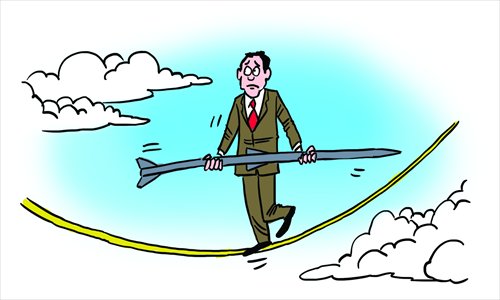Seoul treads tricky line around US, national missile defense needs

Illustration: Liu Rui/GT
Recently South Korea and the US agreed to adopt a "tailored deterrence strategy" against the threat of North Korean nuclear weapons.
The joint communiqué released on October 2 after the annual Security Consultative Meeting said that "This strategy establishes a strategic alliance framework for tailoring deterrence against key North Korean nuclear threat scenarios across armistice and wartime, and strengthens the integration of alliance capabilities to maximize their deterrence effects."
From Seoul's perspective, its adoption is significant in that it develops and codifies the abstract US promise of a nuclear umbrella into an actual operational plan.
But it could increase the chances of a nuclear conflict, since it also contains provisions for a "preemptive response" to the detection of signs of the use of nuclear weapons.
Tailored deterrence identifies plans of response for both sides to three stages of North Korean nuclear weapon capabilities: threat, signs of imminent usage, and usage.
This means that in responding actively to a North Korean nuclear threat, the two militaries would be mobilizing all available forces; the US nuclear umbrella, the two sides' conventional military power, and missile defense.
Key to this is the "kill chain" and the Korea Air and Missile Defense (KAMD), which President Park Geun-hye has declared her intention to "establish as soon as possible."
The kill chain is aimed at launching a preemptive strike on the North's asymmetric warfare capabilities, while the KAMD is South Korea's low-altitude air and missile network for intercepting Pyongyang's missiles after launch.
South Korea is planning on pouring 15 trillion won ($14 billion) into these two projects through 2022.
US Defense Secretary Chuck Hagel said on October 2 that "The South Korean and US missile defense systems don't have to be identical as long as they are interoperable."
His remarks suggest that South Korea is not obliged to take part in the US system, but that the two countries' systems should allow for inter-operation.
The US government under President Barack Obama views the establishment of a US-led missile defense system linking South Korea, Japan, and the US as a key goal during its rebalancing to the Asia-Pacific region.
However, the South Korean government has persistently denied the possibility that its missile defense could be incorporated into the US system.
Seoul is particularly concerned that Seoul's official participation in US missile defense could lead to the worst possible scenario for its national security, by being hustled onto the front lines in a major power conflict pitting the US and Japan against China and Russia.
This would make it impossible for Park to carry out her policy goals of cooperating with China while maintaining an alliance with the US and bringing about change in North Korea.
And in an environment like the Korean Peninsula where firing ranges are so short, the most effective missile defense system is low-altitude defense. Both South and North Korea have maximum firing ranges of just 1,000 kilometers.
The US missile defense system, in contrast, would be designed mainly to intercept intercontinental ballistic missiles.
These issues are tied to another postponement of the transfer of wartime operational command (OPCON) of South Korean army from the US. With the OPCON transfer slated for December 2015, Seoul asked Washington to reconsider the process, citing increasing threats from Pyongyang.
It can be inferred that Washington used Seoul's request for delaying the OPCON handover as a way of accomplishing its own long-standing desire to building a three-way missile defense system in Northeast Asia.
South Korea is in a strategic dilemma. Seoul finds it hard to oppose the US requests to contribute to its missile defense system, taking into account the need to step up security coordination involving Washington against North Korea.
However, Seoul is also conscious of the repercussions, which could provoke China and Russia and exercise a bad influence on North Korean nuclear problem. Seoul is walking a tightrope between US needs and its own.
The author is a professor with the Asiatic Research Institute of Korea University. opinion@globaltimes.com.cn